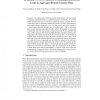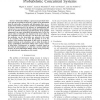46 search results - page 2 / 10 » Adversaries and Information Leaks (Tutorial) |
EUROCRYPT
2004
Springer
13 years 10 months ago
2004
Springer
Denoting by P = [k]G the elliptic-curve double-and-add multiplication of a public base point G by a secret k, we show that allowing an adversary access to the projective representa...
ESORICS
2011
Springer
12 years 5 months ago
2011
Springer
The rapid progress of human genome studies leads to a strong demand of aggregate human DNA data (e.g, allele frequencies, test statistics, etc.), whose public dissemination, howeve...
CCS
2011
ACM
12 years 5 months ago
2011
ACM
We introduce a novel model of routing security that incorporates the ordinarily overlooked variations in trust that users have for different parts of the network. We focus on ano...
CCS
2007
ACM
13 years 11 months ago
2007
ACM
Low-latency anonymity systems such as Tor, AN.ON, Crowds, and Anonymizer.com aim to provide anonymous connections that are both untraceable by “local” adversaries who control ...
QEST
2010
IEEE
13 years 3 months ago
2010
IEEE
Information hiding is a general concept which refers to the goal of preventing an adversary to infer secret information from the observables. Anonymity and Information Flow are exa...


